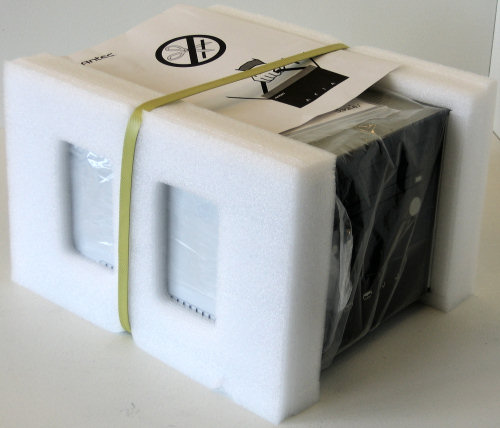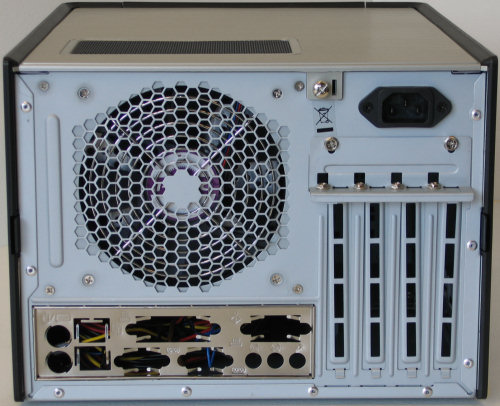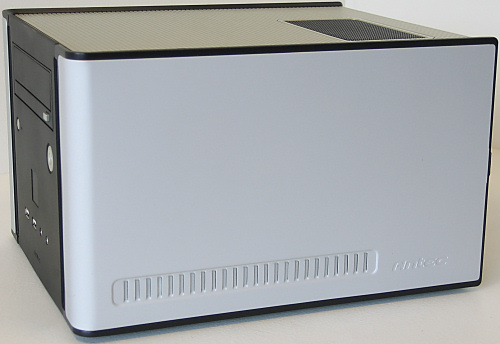Micro-ATX Cases - Shoebox Showdown
by Joshua Buss on January 2, 2007 12:40 PM EST- Posted in
- Cases/Cooling/PSUs
Antec Aria - Exterior
We've had requests to look at the Aria for well over a year now, but only recently were we able to get enough micro-ATX cases to compare against each other for a full-fledged review. Normally our policy on taking pictures of packaging is that we'd expect any manufacturer to protect their product substantially, and we will only make mention of a product's particular packaging job if it's deplorable or substantially better than average. With the small Aria, we were very happy to see Antec using soft foam blocks rather than typically messy Styrofoam or peanuts, and immediately we had a sense that this case was incredibly tough due to its weight for such a small unit.
The Aria reminded us of the P180 very much - only obviously much smaller - primarily due to its multi-material construction. The frame of the case is mostly steel, but aluminum and plastic are both used for panels and trim pieces. The simple front gives the first clue that the case is smaller than most mATX PCs and even many proprietary SFFs, as it is designed to hold only a single optical drive. There are a couple other key points about the front. All three buttons are plastic but still have a good feel, and the front ports are all nicely spaced apart for larger devices. HDD activity is shown with a blue LED to the right of the reset button, and as long as the system is powered on blue LEDs shine up from the bottom of the slits on the left and right side.
More than just about any other mATX case, the Aria really does resemble a large shoebox in its dimensions. However,,its looks are a little more interesting than dual-tone cardboard. We really like the look the black trim gives the case, and the ribbed top is an interesting touch we've come to appreciate. This top cover is plastic on the top and metal underneath including its grill above the PSU, and the equally hefty side panels are plastic inside and around the edges to dampen vibrations. Thanks to the combination of materials the case is quite resilient to fingerprints for the most part, but the exposed aluminum on the sides is not your typical brushed anodized finish and can pick up smudges or scratches a little easier.
Taking a closer look at the back we can get a sense of the custom-made PSU which allows the Aria to be so compact. Sporting a large fan, the PSU will be able to move plenty of air through the small case without making too much noise. Expansion card retention is done with two standard case screws for a special bracket and one screw for the card itself.
The right side of the case has an impression of "Antec" in the lower right corner and contains the same ventilation perforations as the other side along the bottom. The case's feet are soft rubber and add to the total sound dampening effect as well as keep it from sliding around like some wheeled cases.
More information on the Aria is available on Antec's website.
We've had requests to look at the Aria for well over a year now, but only recently were we able to get enough micro-ATX cases to compare against each other for a full-fledged review. Normally our policy on taking pictures of packaging is that we'd expect any manufacturer to protect their product substantially, and we will only make mention of a product's particular packaging job if it's deplorable or substantially better than average. With the small Aria, we were very happy to see Antec using soft foam blocks rather than typically messy Styrofoam or peanuts, and immediately we had a sense that this case was incredibly tough due to its weight for such a small unit.
 |
| Click to enlarge |
The Aria reminded us of the P180 very much - only obviously much smaller - primarily due to its multi-material construction. The frame of the case is mostly steel, but aluminum and plastic are both used for panels and trim pieces. The simple front gives the first clue that the case is smaller than most mATX PCs and even many proprietary SFFs, as it is designed to hold only a single optical drive. There are a couple other key points about the front. All three buttons are plastic but still have a good feel, and the front ports are all nicely spaced apart for larger devices. HDD activity is shown with a blue LED to the right of the reset button, and as long as the system is powered on blue LEDs shine up from the bottom of the slits on the left and right side.
 |
| Click to enlarge |
More than just about any other mATX case, the Aria really does resemble a large shoebox in its dimensions. However,,its looks are a little more interesting than dual-tone cardboard. We really like the look the black trim gives the case, and the ribbed top is an interesting touch we've come to appreciate. This top cover is plastic on the top and metal underneath including its grill above the PSU, and the equally hefty side panels are plastic inside and around the edges to dampen vibrations. Thanks to the combination of materials the case is quite resilient to fingerprints for the most part, but the exposed aluminum on the sides is not your typical brushed anodized finish and can pick up smudges or scratches a little easier.
 |
| Click to enlarge |
Taking a closer look at the back we can get a sense of the custom-made PSU which allows the Aria to be so compact. Sporting a large fan, the PSU will be able to move plenty of air through the small case without making too much noise. Expansion card retention is done with two standard case screws for a special bracket and one screw for the card itself.
 |
| Click to enlarge |
The right side of the case has an impression of "Antec" in the lower right corner and contains the same ventilation perforations as the other side along the bottom. The case's feet are soft rubber and add to the total sound dampening effect as well as keep it from sliding around like some wheeled cases.
 |
| Click to enlarge |
More information on the Aria is available on Antec's website.










37 Comments
View All Comments
jmke - Wednesday, January 3, 2007 - link
Do you have a picture of your test room? 15dB (I guess A weighed) seems awfully low :)JoshuaBuss - Wednesday, January 3, 2007 - link
It is very low.. in our old location we couldn't get any lower than 23 dB and now we're further away from the highway. All I know is that's what my new meter says if everything is silent and the dogs next door aren't barking.JoshuaBuss - Wednesday, January 3, 2007 - link
Whoa, I'm sorry.. it was supposed to be 18 dB. Updated.KayKay - Tuesday, January 2, 2007 - link
I built a machine for my brother using the Ultra microfly and it is a great case. The deciding factors for this was the ability to accept a Full-Size Power supply and the removable motherboard tray. They make this in several colours, as well as clear-sided versions. A small box with the ability to put some powerful components in it! 3800x2 with a 7600GT, this thing runs super quietCuriousMike - Tuesday, January 2, 2007 - link
I *just* built a machine three days ago using the Aria (NSK1300) as the basis; I just wanted something smaller than a tower case. I didn't see the review mention the case as being the NSK1300--- the Aria (IIRC) was all black. The case you reviewed is identical to the NSK1300.My build included a Frys X2 4200 "EE" combo deal with ECS C51GM motherboard.
The retail box AMD fan must have been running full tilt all the time (3000rpm sound right?)... it was the noisiest in the case. The CPU would reach 70' under Prime95 load within about 20 minutes, idleing at around 50'.
I replaced the stock HSF with a Zalman CNPS8000, which was reviewed poorer than the 7000 used in this review. The 8000, at anything other than it's lowest fan setting, is as loud as the AMD retail unit; at it's lowest fan setting, it *just* beats the cooling capacity of the stock HSF; running around 50' idle, and 69' with Prime load.
With the 8000 at full RPM, it only knocks a few degrees... 67'. The machine runs hot.
I used a evga 7600GTS and put a zalman 7000 GPU cooler on it (using the slowest fan setting); that made it go from idleing around 54' to 48', and running ATITool for 15 minutes, stock fan was 71', zalman brought it down to 65'.
With the current fan setup, the machine is tolerable noise wise. It's nowhere near silent.
The NSK1300 is cramped... almost impossible to route cables neatly.
It's pretty slick removing all the panels and the drive cage.
Myrandex - Tuesday, January 2, 2007 - link
I have the Lian Li PC-V300 and given its popularity with this crowd, I would have loved to see it included in there. I look forward to finishing the article as it is great so far.JoshuaBuss - Tuesday, January 2, 2007 - link
There are still a few more mATX cases on deck to be looked at soon.. hopefully the V300 will be one of them too.tayhimself - Tuesday, January 2, 2007 - link
I can't for the life of me find a good uATX motherboard with decent overclocking features for a core2 chip. I would like to build a uATX system but I havent gone with one because of the motherboards.Staples - Tuesday, January 2, 2007 - link
Unfortunately, good motherboards are not made in this size or even micro ATX for that matter. There are some decent P965 boards made in micro ATX sizes but the best ones are all in full sized ATX.JarredWalton - Tuesday, January 2, 2007 - link
µATX, uATX, mATX, and micro ATX are all the same thing. (u is the abbreviation used for mu a lot of the time - m already being taken by "milli" and most people not want to bother with the special symbol µ.)